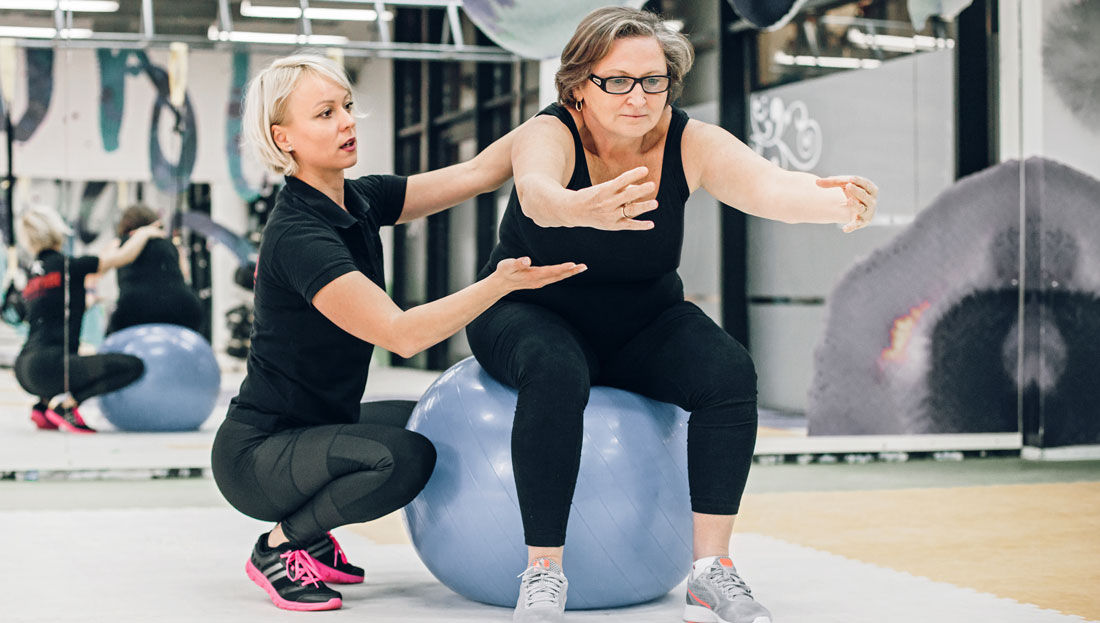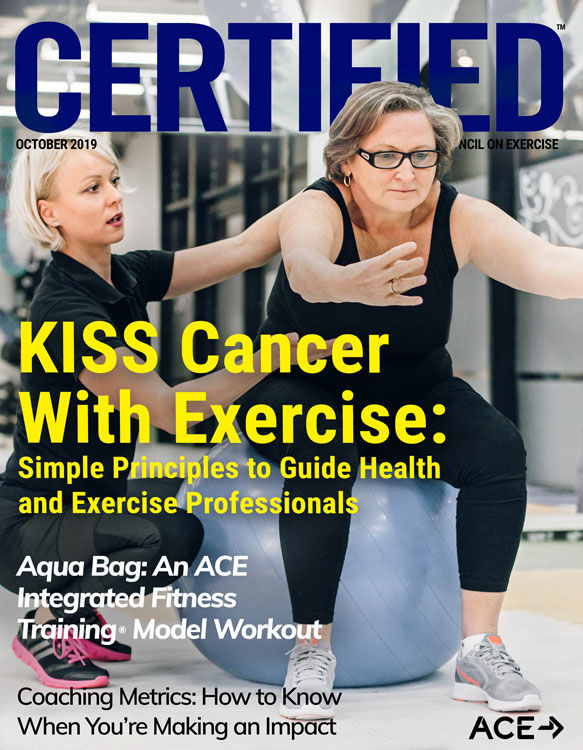
“Even though I was more than two years from cancer treatment and surgeries, I wasn’t able to lie down on the floor to play Legos with my 5-year-old son. I didn’t know how to explain to him that even though I wanted to, I couldn’t.”
This quote is from a cancer survivor prior to beginning an exercise program. For nearly 50 years, individuals within the fitness and medical research communities have sought to understand how exercise may improve the quality of life for individuals who have been affected by cancer. This has been a tireless journey and the evidence is clear: Exercise is beneficial, safe and feasible for individuals with cancer, including those with advanced illness and complex treatment plans. A growing body of research, including these findings by Wolin and colleagues (2012), raise two important questions:
- Why is exercise not recommended as a standard of care?
- If exercise were included as a standard of care, who should be responsible for monitoring implementation and managing the recommendations (i.e., physicians, exercise professionals or both)?
A cancer survivor is anyone living after a diagnosis of cancer. To move into the cancer treatment space requires that health and exercise professionals, including those who are community-based, have access to the information and skills necessary to provide support and guidance to help cancer survivors live as well as possible after a diagnosis. The majority of cancer survivors who seek exercise guidance will do so in the community setting with health and exercise professionals who may not have the knowledge and skills to support them in the best way possible.
Currently, the American Cancer Society and the American College of Sports Medicine (ACSM) recommend that anyone affected by cancer (in accordance with all age-related physical activity guidelines) should avoid inactivity, return to daily activities as soon as possible after surgery, and continue with their normal activities and exercise as much as they are able during and after non-surgical treatments (Schmitz et al., 2010). The recommendations include 150 minutes of moderate or 75 minutes of vigorous aerobic exercise and two to three sessions of resistance training of major muscle groups weekly (ACSM, 2018). These recommendations, however, are lacking the specificity that is necessary to provide high-quality individualized exercise programming for cancer survivors and do not consider the individual’s history, preferences and goals.
We have the evidence to develop much better exercise recommendations and we must do better for the nearly 16 million cancer survivors currently living in the United States. These individuals are living longer after cancer, with more aggressive disease and treatment plans, and are recognizing the need for exercise in their lives. The baseline recommendations are available to provide a foundation for exercise and, as a health and exercise professional, you are on the front lines for the cancer survivor population.
In a notable study, only 20% of oncology care providers (physicians and nurses) were even aware that exercise guidelines for patients existed. Notably, this research also indicated that medical providers who met general exercise guidelines themselves were much more likely to discuss the importance of exercise with their patients (Nadler et al., 2017). The research-to-practice gap provides an opportunity for health and exercise professionals to fill the void. As change agents, we need to make it known that we are willing, ready and able to become part of a truly multidisciplinary cancer care team.
Who Should Exercise With a Cancer Diagnosis? And When?
In the past several decades, a significant body of research has underscored the importance of exercise, from prevention through survivorship and end of life.
From a prevention standpoint, the amount of leisure-time physical activity has been shown to reduce the risk of 13 different types of cancer (Moore et al., 2016) and significantly improve treatment-related side effects such as nausea and pain (van Waart et al., 2015). Overall survival outcomes improve length of life by four-and-a-half years, even with very low levels of exercise. (Cassileth, Yarett and Lemanne, 2016). In the palliative setting, such as with advanced and often incurable cancers, exercise has been shown to improve functional capacity, which is often reduced by disease and treatment. For example, a 12-week combined exercise and relaxation intervention with individuals who had advanced lung cancer showed improvements in all aspects of quality of life including function and anxiety (Quist et al., 2015).
If you are a health and exercise professional who is already part of a clinical cancer team, it may be difficult to keep up with the research, and implementation of best practices can often seem daunting. Part of the issue with implementation is the tendency to define cancer survivors by their diagnoses, rather than understanding the broader context of each individual’s lifestyle. Evidence has shown that obesity is a risk factor for at least 13 types of cancer including esophageal, liver and multiple myeloma, which are an expansion on the hormonally related common cancers such as breast, endometrial and prostate (Lauby-Secretan et al., 2016). Even with these more startling numbers, cancer survival rates are improving and survivors are living longer due to advances in treatment strategies and innovative therapies. According to the American Cancer Society, the five-year survival rate has improved in nearly all types of cancer. While this varies by type of cancer, the death rate from 1991-2016 has improved by 26%, which translates to 2.6 million fewer deaths.
Although comorbidities are also on the rise and survivors are living with a multitude of side effects that impact quality of life, research supports the idea that exercise is a key component to ensuring a cancer survivor lives the best possible life. The following three themes underscore this point:
- Basic exercise recommendations for cancer survivors are the same as for the generally healthy population, indicating survivors are capable and that the mere diagnosis does not prohibit exercise.
- Clinical evidence has established that exercise is beneficial for prevention, pre-habilitation and treatment.
- Certified health and exercise professionals understand basic physiology and motivational interviewing to be able to support and guide the person standing in front of them. Basic guidelines are available to make these referrals happen.
The KISS method, which includes four primary components—kinesiology, interview, strength and support—is a framework to help guide your assessment of cancer survivors who are looking for direction in reaching their goals, while also keeping them safe, which ultimately will keep them coming back to their fitness plan. This approach is simple and also allows for the flexibility required to meet an individual’s needs. Although they share a common diagnosis of cancer, survivors do not fit into a box and are, in fact, a very heterogeneous population. Heterogeneity is particularly evident with the more commonly diagnosed cancers such as breast cancer.
To efficiently assess your new client, follow these steps:
Kinesiology: Focusing on kinesiology involves observing how your clients move. Is their gait slow or compromised? What does their posture look like? How do they sit or stand? Observe how clients perform simple functional movements such as squats, step-ups, full overhead reaches or elevated push-ups.
Interview: It is important to get information beyond a PAR-Q+ (Physical Activity Readiness Questionnaire for Everyone). Interviews should include information about the client’s cancer such as type, location and treatments (e.g., chemotherapy, radiation and/or surgery). It isn’t necessary to know every treatment-related side effect, but it will be critical to know if the client is experiencing current side effects related to cancer treatment. Not making assumptions and getting specifics about the person with whom you are working will help you make appropriate exercise modifications and program adjustments. Document and investigate medications and their side effects.
Strength: Do not assume a survivor is fragile or broken because of his or her diagnosis. However, it is important to understand that individuals may be physically weak due to deconditioning, uncertain about what they should or should not do and expect guidance from you to achieve their fitness goals. Cancer survivors may have a deep need to feel strong physically and mentally and could potentially rely on health and exercise professionals for support with this.
Resistance exercise is a crucial component of KISS. Up to 96% of cancer survivors report fatigue, making it the most common side effect (Stasi et al., 2003). This can be mitigated by muscular exercise. Additional benefits of resistance training include a reduction in deconditioning and improved function, metabolism, independence and survival. Guide a cancer survivor as you would other clients, ensuring the proper level of intensity and correct form and he or she will see and feel physical improvement.
Support: The importance of this component cannot be overstated, and the survivor should be provided reassurance and guidance both physically and emotionally. When exercise is included in the treatment plan, survivors often thrive and the encouragement from the health and exercise professional is an important component as energy levels fluctuate. Offering guidance on how to modify physical activity is important. Other factors include surgical limitations, neuropathy (numbness and tingling in the hands and/or feet), scar tissue and joint achiness. Helping alleviate fears and uncertainty will keep survivors coming back to the gym even when they aren’t feeling their best.
Case Study: Leslie, Breast Cancer Survivor
The following case study demonstrates how the KISS framework can be applied to a client who is a breast cancer survivor.
Leslie was diagnosed at age 39 with stage IIIB triple negative breast cancer. She begins her quest for formal exercise 18 months after diagnosis. She is about six months post-treatment and her hair is beginning to return. While her mother had breast cancer, it was a different type and she is not known to have any genetic mutations, even with her Ashkenazi Jewish heritage.
Treatment
Chemotherapy: Six rounds of chemotherapy including Adriamycin, Cytoxan and Taxol, which she began less than two weeks after diagnosis due to the aggressive nature of her disease.
Surgery: Leslie had a bilateral mastectomy with axillary node dissection. Sentinel nodes were injected with dye to find “lead” nodes to detect the presence of cancer cells. Triple negative means that all known markers (estrogen, progesterone and HER-2 protein) were absent, indicating that Leslie’s cancer was not fueled by hormones. The surgery included immediate expander placement under the pectoral muscles.
Radiation: Leslie had 30 radiation treatments after she finished chemotherapy and recovered from surgery.
Other Factors
Leslie’s surgical incision did not heal well and became infected, despite being treated with antibiotics. Eventually, the expanders were removed, and she was unable to have reconstruction. She wears prostheses when she wishes to have the appearance of breasts, and she does not exercise with her prostheses.
Leslie did not exercise during treatment, nor was she advised to do so. During treatment, Leslie experienced nausea and ate what she could. She did not gain weight on the scale during treatment, but reports that the fit of her clothes changed and were much tighter in the areas where she normally gains weight.
Leslie has class 2 obesity, with a BMI of 36.1 kg/m2, but carries a significant amount of muscle on her body. She does not have a history of exercise but was interested in being healthier and finding something she would enjoy. Leslie has had overweight most of her life, but her body composition has changed throughout the years. She also takes medication for bipolar disorder but feels this is managed well.
While healthy body composition is important to Leslie long-term and for other comorbidities, body fat did not play a role in her cancer diagnosis and therefore she does not need to have additional surgeries to remove her ovaries or take any post-treatment medications such as estrogen blockers and aromatase inhibitors.
Leslie only had three lymph nodes removed so her risk for lymphedema is low; however, obesity and the fact that she had Taxol-based chemotherapy and radiation increases her risk. Even with the risk, it is not necessary for her to wear a compression garment because she was not diagnosed with lymphedema. She should still pay attention to changes such as swelling and infection. She does not have any reported neuropathy related to the chemotherapy, but does have general tightness in her shoulders, forearms and wrists, which is much more likely due to her working at a desk and computer daily.
Leslie has a history of lower-back surgery with disc decompression, in large part due to weight and physical inactivity. She has tight pectorals due to scar tissue and being naturally protective of these areas. She reports knee pain with varying degrees of intensity. She participated in an intense walking clinical trial at her local cancer center (more than 90 minutes daily on a treadmill at a brisk speed) but reported increased pain in her lower back and lower extremities.
She is very busy and works full time in a demanding but enjoyable profession that requires her to be both analytical and social. She is married (her husband is also a cancer survivor) and has a teenage daughter.
Client Goals
Leslie’s goals are to improve her function and body composition. She also is looking for an exercise program that she will stick with over the long-term. Leslie enjoys the strength component of exercise and she would like to learn how to do movements such as squats and deadlifts. She is concerned about high-impact activities such as running and feels physically uncomfortable with yoga. She also wants to improve her energy and reduce daily pain.
Leslie’s KISS Plan
K - Leslie has a normal gait and movement pattern, and slight difficulty doing squats. She feels slight pain in her knees, but she states this is not uncommon. She has a slightly rounded-forward posture that, upon functional evaluation, is attributable in part to tight shoulder and pectoral muscles. Leslie states that she is a bit nervous today and tends to cross her arms over her chest during the interview.
I - During the interview, Leslie shares a little about her treatment history and information about why she does not have breasts. She mentions that she feels numbness in her hands at times and wonders if it is related to her cancer treatments. Based on Leslie’s concerns, the health and exercise professional makes a note to look up more about her chemotherapy and recommends she discuss concerns about neuropathy with her doctor.
S - Leslie is interested in resistance training. She would like to especially gain strength in her lower body but shares that she has been told frequently by doctors and others in her network that she shouldn’t perform exercises such as squats and deadlifts because of her back issue.
S - Leslie has never been a regular exerciser and has always felt out of place in exercise spaces. Leslie shares that she has always dealt with being overweight, but has a desire to use her muscles to move heavy weights. She has a strong desire to try strength training, but is also nervous about upper-body exercises, such as the bench press, after her surgeries.
Recommendations
The health and exercise professional recommends that Leslie start in phase one of the ACE Integrated Fitness Training® (ACE IFT®) Model with a focus on stability and mobility and muscular balance, with a longer-term plan that eventually includes movement training with added load. She will benefit from the focus on muscular conditioning in a manner that helps her move comfortably. Increasing her lean muscle mass will improve her basal metabolic rate and contribute to an overall plan to improve body composition. Given her history of low-back pain and her desire to lift heavier weights, she is given a 10-minute daily core and mobility plan that she can do at home.
After a brief period of cardiorespiratory training with an initial focus in the Base Training phase of the ACE IFT Model, the health and exercise professional recommends that her cardiorespiratory exercise progresses to be HIIT-focused, with shorter, higher-intensity bouts. Interval training will allow her to push the limits of her peak anaerobic threshold while offering some recovery to keep her engaged.
Long-term Needs Related to Cancer History
Maintain a watchful eye for the emergence of any lymphedema, as the risk is low but still present. Significant scar tissue in the pectoral region contributes to tight shoulder and pectoral muscles and numbness in the hands. It’s important to note that this is not related to the chemotherapy because it does improve with mobility. A focus on strength and flexibility of the tissues of the anterior chest wall is important. We maintain good communication about how her lower back and joints are feeling. If her back or hips are sore, we review recent workouts to find potential associations. Fear is very common, so it’s important to remind her that cancer pain doesn’t come and go like exercise-related soreness.
Conclusion
Given that exercise is a standard recommendation for anyone affected by cancer, health and exercise professionals play a crucial role in helping implement and deliver exercise programs for this population. While the initial assessments are essential, the most important thing to remember is to focus on the person in front of you, rather than simply his or her cancer.
REFERENCES
American College of Sports Medicine (2018). ACSM’s Guidelines for Exercise Testing and Prescription, 10th ed. Philadelphia: Wolters Kluwer.
Cassileth, B., Yarett, I. and Lemanne, D. (2016). Fitness: Can exercise lengthen survival in patients with cancer. The ASCO Post.
Lauby-Secretan. B et al. (2016). Body Fatness and Cancer—Viewpoint of the IARC Working Group. The New England Journal of Medicine, 375, 794-798.
Moore, S.C. et al. (2016). Association of leisure-time physical activity with risk of 26 types of cancer in 1.44 million adults. JAMA Internal Medicine, 176, 6, 816−825.
Nadler, M. et al. (2017). Oncology care provider perspectives on exercise promotion in people with cancer: An examination of knowledge, practices, barriers and facilitators. Support Care Cancer, 25, 7, 2297−2304.
Quist, M. et al. (2015). The impact of a multidimensional exercise intervention on physical and functional capacity, anxiety, and depression in patients with advanced-stage lung cancer undergoing chemotherapy. Integrative Cancer Therapies, 341−349.
Schmitz, K.H., et al. (2010). American College of Sports Medicine roundtable on exercise guidelines for cancer survivors. Medicine and Science in Sports and Exercise, 42, 7, 1409−1426.
Stasi, R. et al. (2003). Cancer-related fatigue: Evolving concepts in evaluation and treatment. Cancer, 98, 1786–1801.
van Waart, H. et al. (2015). Effect of low-intensity physical activity and moderate- to high-intensity physical exercise during adjuvant chemotherapy on physical fitness, fatigue, and chemotherapy completion rates: Results of the PACES randomized clinical trial. Journal of Clinical Oncology, 33, 17, 1918−1927.
Wolin, K.Y. et al. (2012). Implementing the exercise guidelines for survivors. Journal of Supportive Oncology, 10, 5, 171–177.





 by
by 


